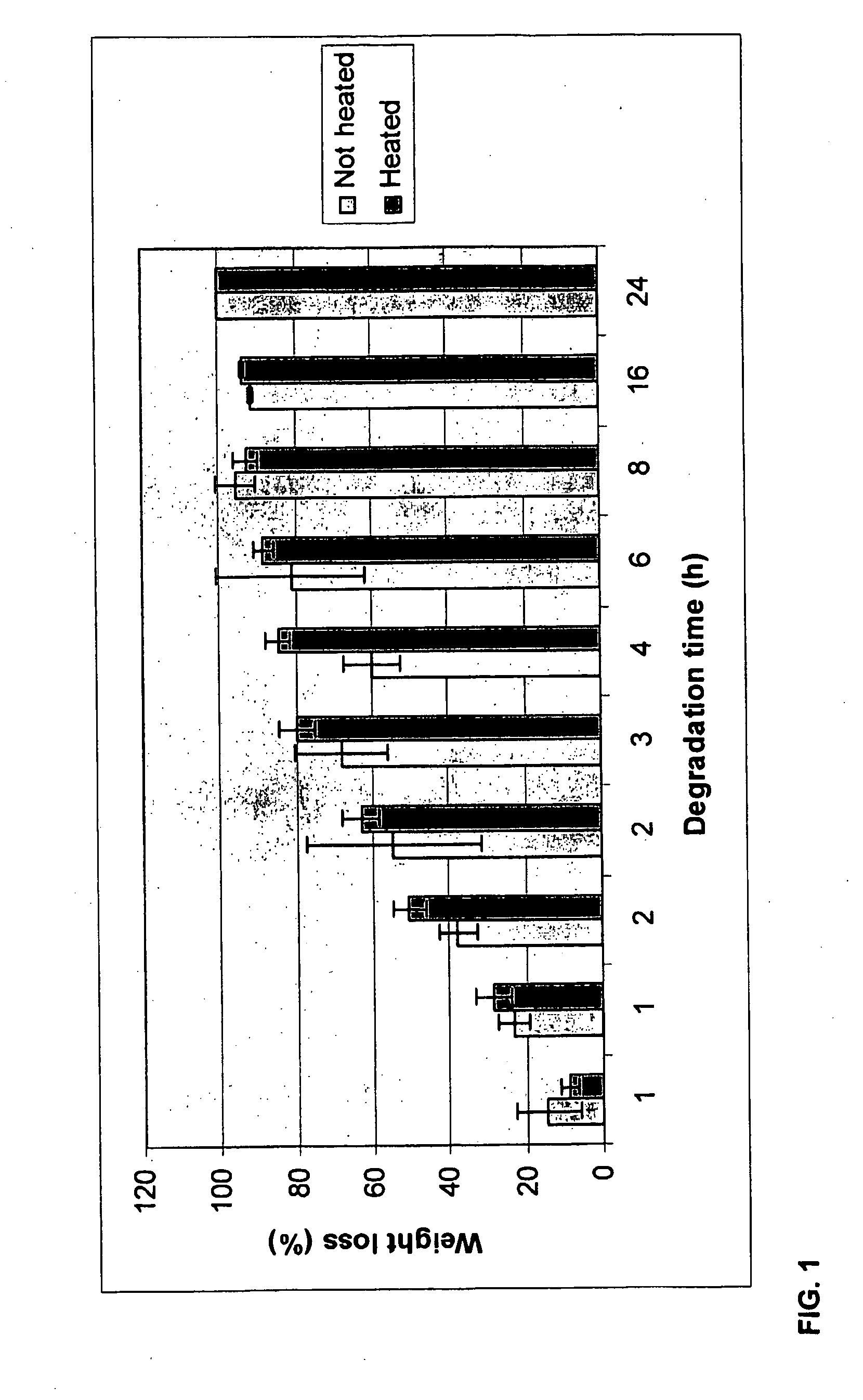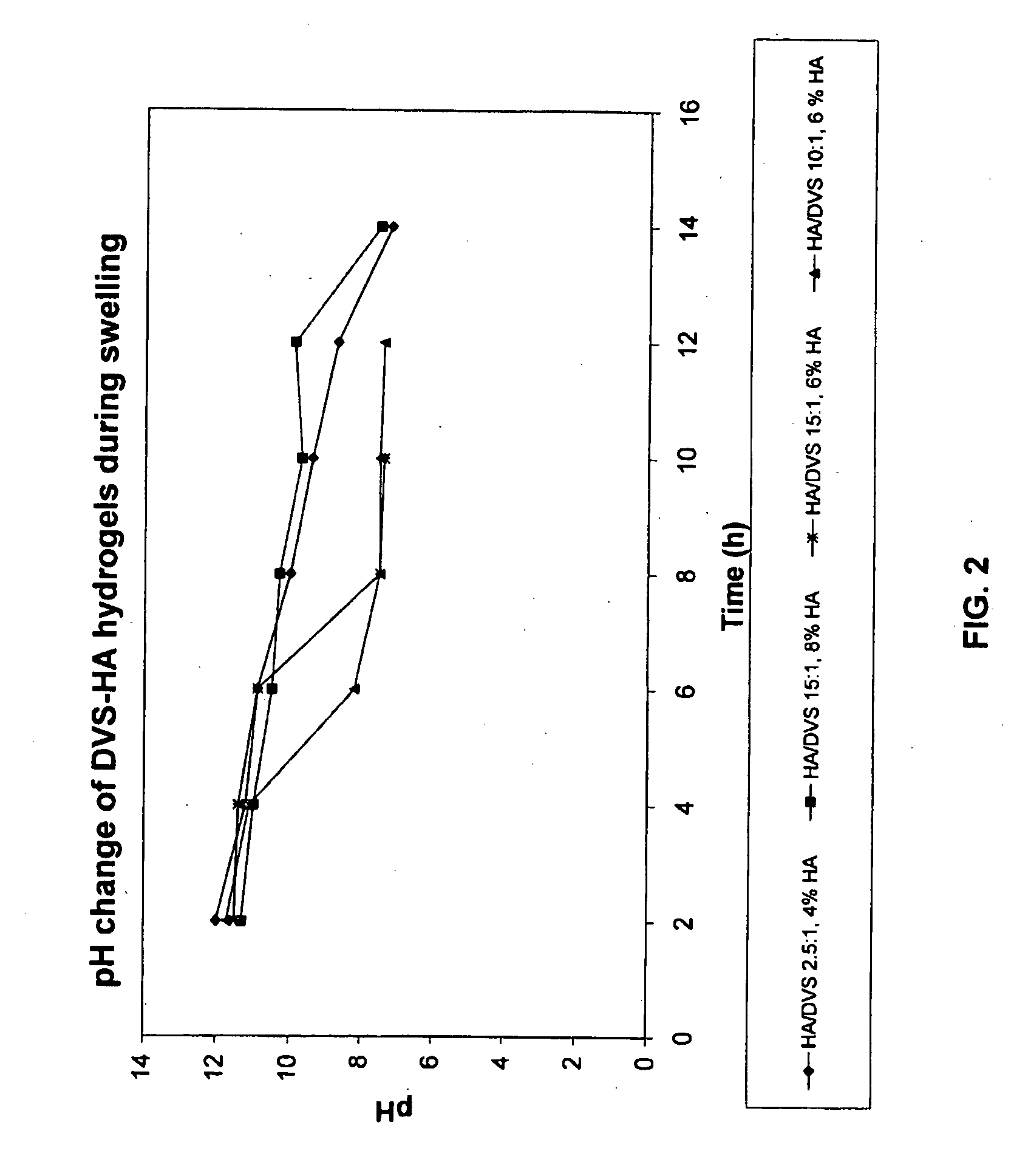Method of cross-linking hyaluronic acid with divinulsulfone
a technology of divinulsulfone and hyaluronic acid, which is applied in the field of cross-linked ha, can solve the problems of limited use of ha in some applications and difficult processing into biomaterials, and achieve the effects of improving properties, increasing homogeneity, and increasing softness
- Summary
- Abstract
- Description
- Claims
- Application Information
AI Technical Summary
Benefits of technology
Problems solved by technology
Method used
Image
Examples
example 1
Preparation of DVS-Crosslinked HA Hydrogels
[0070]This example illustrates the preparation of DVS-cross-linked HA hydrogels with concomitant swelling and pH adjustment.
[0071]Sodium hyaluronate (HA, 770 kDa, 1 g) was dissolved into 0.2M NaOH to give a 4% (w / v) solution, which was stirred at room temperature, i.e. about 20° C., for 1 h. Three replicates were prepared. Divinylsulfone (DVS) was then added to the HA solutions in sufficient amount to give HA / DVS weight ratios of 10:1, 7:1, and 5:1, respectively. The mixtures were stirred at room temperature for 5 min and then allowed to stand at room temperature for 1 h. The gels were then swollen in 160 mL phosphate buffer (pH 4.5 or 6.5) for 24 h, as indicated in Table 1.
TABLE 1Conditions for DVS-HA hydrogel preparation.Gel IDHA / DVS weight ratioPhosphate buffer used for swelling1 5:1160 ml (pH 4.5)2 7:180 ml (pH 4.5) + 80 ml (pH 6.5)310:1160 ml (pH 6.5)
[0072]The pH of the gels was stabilized during the swelling step. After swelling, any ...
example 2
Preparation of Homogenous DVS-Crosslinked HA Hydrogels
[0074]This example illustrates the preparation of highly homogenous DVS-cross-linked HA hydrogels.
[0075]Sodium hyaluronate (770 kDa, 2 g) was dissolved into 0.2M NaOH with stirring for approx. 1 hour at room temperature to give a 8% (w / v) solution. DVS was then added so that the HA / DVS weight ratio was 7:1. After stirring at room temperature for 5 min, one of the samples was heat treated at 50° C. for 2 h without stirring, and then allowed to stand at room temperature overnight. The resulting cross-linked gel was swollen into 200 ml phosphate buffer (pH 5.5) 37° C. for 42 or 55 h, and finally washed twice with 100 ml water, which was discarded. Volume and pH were measured, as well as the pressure force necessary to push the gels through a 27G*½ injection needle (see Table 3).
TABLE 3Characteristics of DVS-cross-linked HA hydrogels.Stability ofHApressureHeatVolume ofconcentrationforce duringGel IDtreatedswollen gel(w / v)pHAppearance...
example 3
Biostability of DVS-Crosslinked HA Hydrogels
[0076]This example illustrates the in vitro biostability of DVS-cross-linked HA hydrogels using enzymatic degradation.
[0077]A bovine testes hyaluronidase (HAase) solution (100 U / mL) was prepared in 30 mM citric acid, 150 mM Na2HPO4, and 150 mM NaCl (pH 6.3). DVS-HA cross-linked hydrogel samples (ca. 1 mL) were placed into safe-lock glass vials, freeze-dried, and weighed (W0; Formula 1). The enzyme solution (4 mL, 400 U) was then added to each sample and the vials were incubated at 37° C. under gentle shaking (100-200 rpm). At predetermined time intervals, the supernatant was removed and the samples were washed thoroughly with distilled water to remove residual salts, they were then freeze-dried, and finally weighed (Wt; Formula 1).
[0078]The biodegradation is expressed as the ratio of weight loss to the initial weight of the sample (Formula 1). Weight loss was calculated from the decrease of weight of each sample before and after the enzyma...
PUM
| Property | Measurement | Unit |
|---|---|---|
| Temperature | aaaaa | aaaaa |
| Temperature | aaaaa | aaaaa |
| Temperature | aaaaa | aaaaa |
Abstract
Description
Claims
Application Information
 Login to View More
Login to View More - R&D
- Intellectual Property
- Life Sciences
- Materials
- Tech Scout
- Unparalleled Data Quality
- Higher Quality Content
- 60% Fewer Hallucinations
Browse by: Latest US Patents, China's latest patents, Technical Efficacy Thesaurus, Application Domain, Technology Topic, Popular Technical Reports.
© 2025 PatSnap. All rights reserved.Legal|Privacy policy|Modern Slavery Act Transparency Statement|Sitemap|About US| Contact US: help@patsnap.com



